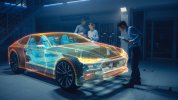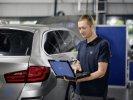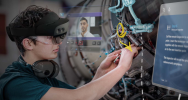
Vehicles are becoming increasingly smarter, more connected, and software defined.
It’s hard to believe a mere 200 years ago, the horse and carriage were the predominant mode of transportation — and had been for hundreds of years. And then, with the invention of the internal combustion engine, moving people and goods changed immensely in a short period of time. Mobility became more accessible, affordable and created opportunities far beyond the scope of imagination.
It was that once-in-a-century change that brought us to where we are today.
Now, we’re facing another once-in-a-century transformation.
The mobility industry is at a critical inflection point. Major innovation is underway: Vehicles are becoming smarter, more connected, and software-defined — and in some cases, autonomous. Electrification is taking hold. A focus on sustainability is rising to the forefront. Innovators in our industry are reimagining every aspect of moving people and goods around the world, and Microsoft is proud to partner with those who are reinventing mobility.
And yet, this metamorphosis is challenged by global macroeconomic challenges, supply chain disruptions, energy shortages and lagging worker availability. It’s never been more important to do more with less.
As we kick off CES 2023 in Las Vegas, we’re bound to see emphasis on both sides of this paradigm shift — innovations that improve mobility while at the same time increasing efficiencies, providing opportunities to reduce our environmental footprint, and connecting people in new ways. As a key partner to the industry, Microsoft has a unique viewpoint into its evolution — we don’t produce vehicles, monetize our customers’ data, or compete with their brands. Instead, we help empower automakers and mobility service providers with intelligent cloud and edge technologies to help them build their own unique digital platforms to push the boundaries of what’s possible.
Microsoft accelerates the transformation of automotive, mobility and transportation companies into data- and software-driven mobility services providers. Azure cloud-based analytics services unlock unique insights collected across customer interactions, data sources, workforce and operations performance, and our extensive cloud services and partner ecosystem enables new revenue streams from differentiated mobility services.
This year’s CES — which kicks off tomorrow — features a dedicated transportation hall, giving us an opportunity to dive in and explore the future of mobility. Here are key themes to watch as organizations bring their latest and greatest to the most influential tech event in the world.

Across industries, a resilient supply chain is top of mind.
1. Creating sustainable, collaborative supply chains that improve resilience.
While resiliency is a key ingredient of long-term organizational viability, it’s taken on a new meaning in the current climate. Just about every industry has felt the cascading impacts of supply chain disruptions, and mitigating those disruptions is crucial to restoring expectations.
In the trucking industry, timing is everything. Ensuring that trucks get to customers on time requires identifying problems early and being able to respond nimbly. But a lack of visibility across the supply chain makes it difficult to know when there are issues that could impact production and, consequently, delivery. To help streamline the processes and keep an end-to-end eye on its entire supply chain, Daimler Truck North America is using the Microsoft Supply Chain Platform to improve visibility, reduce downtime and increase efficiencies.
And when it comes to vehicles, visibility into the supply chain is essential to production. With the new MO360 Data Platform, Mercedes-Benz is connecting its about 30 passenger car plants worldwide to the Microsoft Cloud, enhancing transparency and predictability across its digital production and supply chain. The MO360 Data Platform is the evolution of Mercedes-Benz’ digital production ecosystem MO360 and allows teams to identify potential supply chain bottlenecks faster and enable a dynamic prioritization of production resources.

Empowering frontline workers is critical to agility. ZF has deployed Power Platform to enable employees to collaborate with professional developers.
2. Using AI and connected data to create agile business processes.
AI and data are helping fundamentally reimagine critical business practices and play a key role in streamlining cumbersome, outdated processes. When utilized responsibly, AI and machine learning can have a positive impact on daily life — and many in the industry are taking advantage of opportunities to improve experiences for both employees and customers, while impacting sustainability as well.
Travel and tourism is approaching — and even surpassing — pre-pandemic levels, and American Airlines is preparing for this influx by using technology in new ways to make its business more efficient and the travel experience more seamless for its customers. By building its platform on Microsoft Azure and applying AI, machine learning and data analytics to its systems, it’s been able to reduce time waiting on the runway, saving thousands of gallons of jet fuel per year, and give connecting customers extra time to make their next flights.
With 180+ production locations around the world, empowering frontline workers isn’t a nice to have — it’s a must have for ZF. A global technology company that supplies materials for passenger cars, commercial vehicles and industrial technology, the company has empowered employees to use low-code solutions on Microsoft Power Platform to collaborate with its professional developers. In one example, ZF employees helped improve lean manufacturing audits by developing a solution that eradicated use of spreadsheets and migrated data into robust Power BI reports — and created significant time and resources savings.

Lynk & Co has Microsoft Teams built into the infotainment system of its 01 model.
3. Delivering personalized in-car and customer experiences.
Differentiation is critical when options abound. Brands that invest in knowing their customers and providing specialized experiences throughout the customer lifecycle will excel, and we’re going to see a new emphasis on personalization in the automotive space. No longer are buyers “stuck” with the static experience delivered upon vehicle purchase. In-car personalization through connected and software-defined vehicles unlocks the ability to provide ongoing updates to the vehicle experience.
Just this week, General Motors announced it’s partnering with Microsoft to deploy new software-defined vehicle services. As GM’s Ultifi platform nears deployment in 2023, GM will use Microsoft Azure cloud and AI services to help simplify its software development and bring convenient and secure digital mobility services to millions of customers faster.
And in productivity, Lynk & Co has developed a unique, built-in meetings app within the infotainment system of its 01 model vehicle, working alongside Microsoft. The app enables users to join Teams meetings on the go, bringing a new dimension of the in-car experience and adding versatility to mobility.

Software-driven vehicles are evolving quickly.
4. Embracing innovation with software-driven and autonomous vehicles.
Innovation in the software-defined and autonomous vehicle space is happening at a very fast pace, and we mustn’t overlook the importance of coming together to reduce complexity and encourage collaboration. Together, we can go farther, faster.
We believe an open-source environment is critical to long-term success, and the work that the Eclipse Foundation is driving is key to delivering this. Microsoft intends to improve developer efficiencies by providing a layer of abstraction that simplifies management of the underlying in-vehicle architecture and lower-level capabilities, and we’ve contributed two projects that focus on modern Application Programming Model and Digital Twins to the foundation’s work. These two interrelated projects aim to significantly reduce the complexity involved in developing in-vehicle applications and enable a large developer community.
We continue to support the development of assisted and autonomous driving and are excited with the partnership with many players in the industry including Wavye, Cruise and others.
This week, Supernal, Hyundai Motor Group’s Advanced Air Mobility company, announced a collaboration with us to advance autonomy, digital operations and cloud integration technologies for the aviation industry by running on the Microsoft Cloud platform. With Microsoft Azure, Supernal can leverage the flexibility and cloud computing power needed to run secure simulations at scale and accelerate its time to commercialization.

The industrial metaverse empowers OEMs to streamline training and improve service regardless of geographic location.
5. Designing new experiences in the metaverse that inspire, connect and empower.
“Metaverse” is perhaps the buzzword of the industry, with much excitement building about what’s possible in this new dimension. We’re seeing several applications that are particularly effective in the industry, on both the industrial and consumer-facing sides.
In particular, the industrial metaverse offers opportunities for improved training scenarios, with experts and those connecting with them able to be geographically dispersed.
With HoloLens 2 and Dynamics 365 Guides, automakers like Toyota Motor North America, Nissan Motor Corporation and others, train employees without having experts physically in the same location, without stacks of paper manuals, and in a way that makes it possible for employees to learn while doing. This approach can reduce the time required to learn new processes and skills, and the content can be created without special programming or IT skills.
And we’re seeing our customers embrace streamlining and improving consumer-facing experiences as well. Recently, FIAT announced a fully virtual showroom for its new FIAT 500 hosted in the metaverse and running on Microsoft Azure, where customers in Italy can interact with product specialists to discover the vehicle, simulate a test drive on the famous La Pista 500, and make a new vehicle purchase — from the comfort of their couches. Developed with Microsoft and Touchcast, you can experience this virtual showroom now.
These are just a few of the trends we expect to continue into the coming year. While none of us know exactly what’s to come, one thing’s for sure — the industry is evolving faster than ever before — and we are excited to help empower a safe, sustainable and productive future of mobility.
The post The future of mobility is now: Five themes to watch at CES 2023 appeared first on The Official Microsoft Blog.
Continue reading...